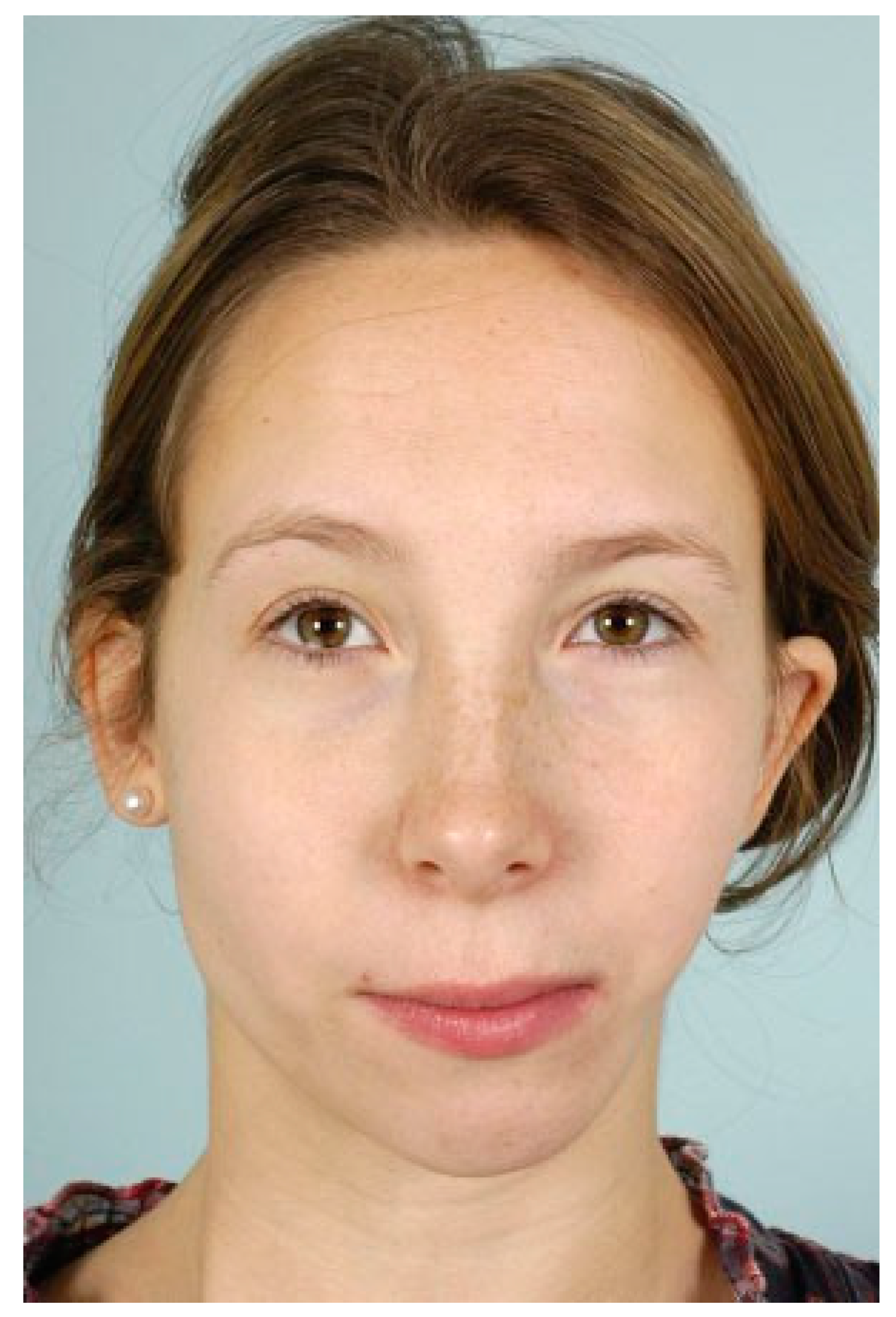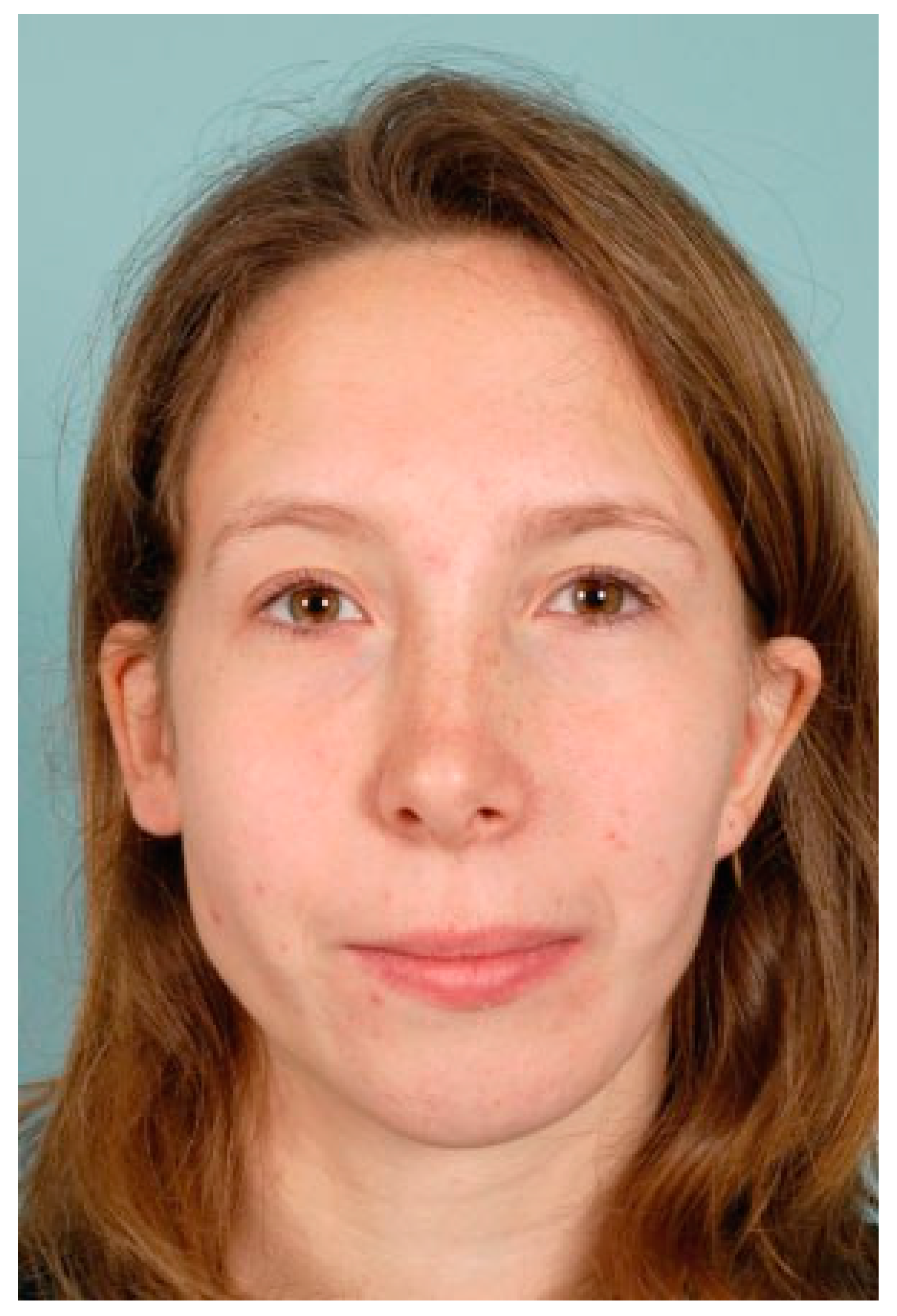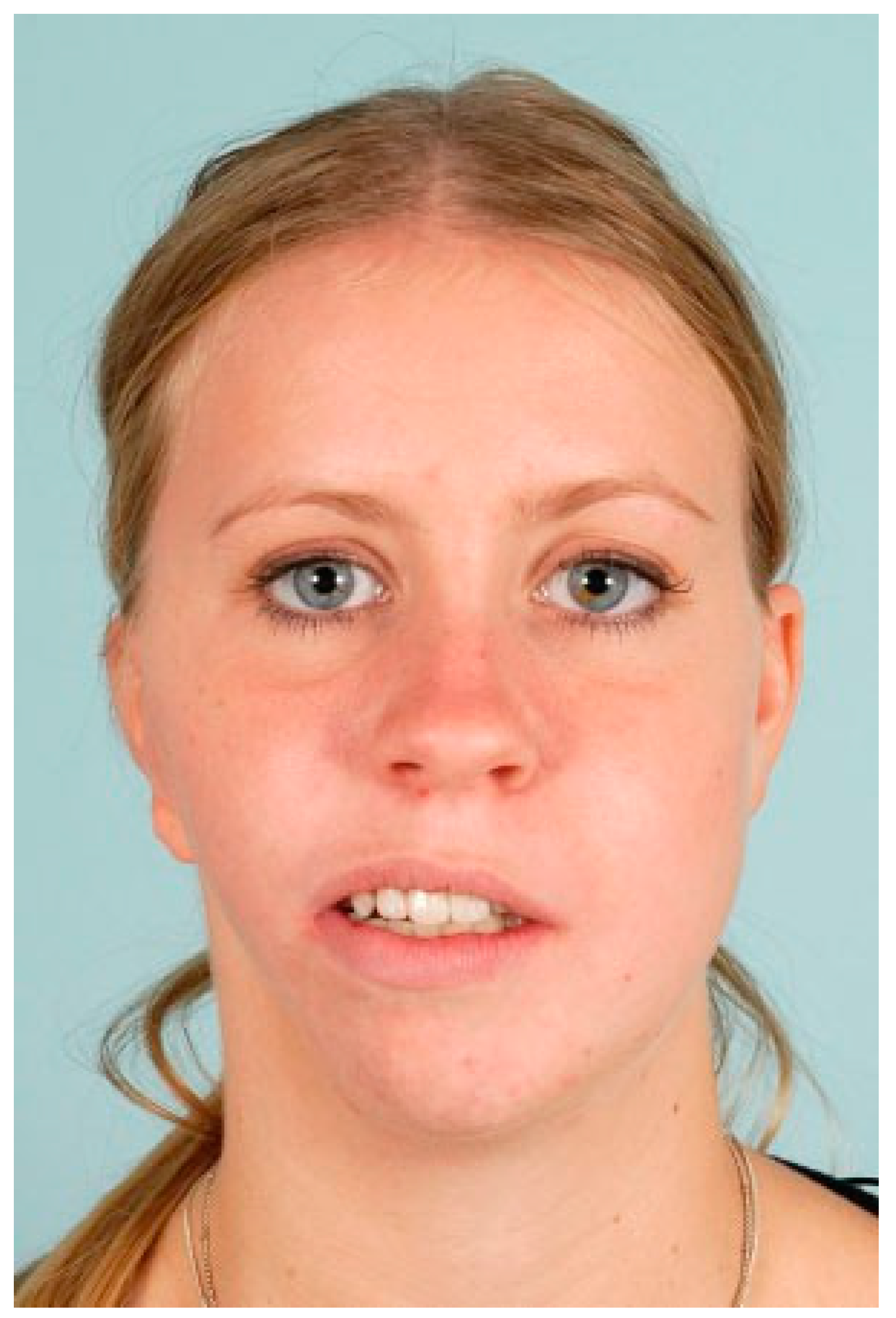Patient-Specific Implant for Residual Facial Asymmetry Following Orthognathic Surgery in Unilateral Craniofacial Microsomia
Abstract
Patients and Methods
Case 1
Case 2
Discussion
References
- Ohtani, J.; Hoffman, W.Y.; Vargervik, K.; Oberoi, S. Team management and treatment outcomes for patients with hemifacial microsomia. Am J Orthod Dentofacial Orthop 2012, 141 (Suppl. 4), S74–S81. [Google Scholar] [CrossRef] [PubMed]
- Cousley, R.R.J.; Calvert, M.L. Current concepts in the understanding and management of hemifacial microsomia. Br J Plast Surg 1997, 50, 536–551. [Google Scholar] [CrossRef] [PubMed]
- Heike, C.L.; Hing, A.V. Craniofacial microsomia overview. In Pagon RABT; Dolan, C.R., Stephens, K., Eds.; GeneReviews, 2010 Edition; University of Washington: Seattle, WA, USA, 2010. [Google Scholar]
- Pluijmers, B.I.; Caron, C.J.J.M.; Dunaway, D.J.; Wolvius, E.B.; Koudstaal, M.J. Mandibular reconstruction in the growing patient with unilateral craniofacial microsomia: A systematic review. Int J Oral Maxillofac Surg 2014, 43, 286–295. [Google Scholar] [CrossRef] [PubMed]
- Guijarro-Martínez, R.; Miragall Alba, L.; Marqués Mateo, M.; Puche Torres, M.; Pascual Gil, J.V. Autologous fat transfer to the cranio-maxillofacial region: Updates and controversies. J Craniomaxillo-Fac Surg 2011, 39, 359–363. [Google Scholar] [CrossRef]
- Cobb, A.R.; Koudstaal, M.J.; Bulstrode, N.W.; Lloyd, T.W.; Dunaway, D.J. Free groin flap in hemifacial volume reconstruction. Br J Oral Maxillo-Fac Surg 2013, 51, 301–306. [Google Scholar] [CrossRef]
- Sbordone, L.; Toti, P.; Menchini-Fabris, G.B.; Sbordone, C.; Piombino, P.; Guidetti, F. Volume changes of autogenous bone grafts after alveolar ridge augmentation of atrophic maxillae and mandibles. Int J Oral Maxillofac Surg 2009, 38, 1059–1065. [Google Scholar] [CrossRef]
- Moon, B.J.; Lee, H.J.; Jang, Y.J. Outcomes following rhinoplasty using autologous costal cartilage. Arch Facial Plast Surg 2012, 14, 175–180. [Google Scholar] [CrossRef] [PubMed]
- Gui, L.; Zhang, Z.; Zang, M.; et al. Restoration of facial symmetry in hemifacial microsomia with mandibular outer cortex bone grafting combined with distraction osteogenesis. Plast Reconstr Surg 2011, 127, 1997–2004. [Google Scholar] [CrossRef] [PubMed]
- Yaremchuk, M.J. Facial skeletal reconstruction using porous polyethylene implants. Plast Reconstr Surg 2003, 111, 1818–1827. [Google Scholar] [CrossRef] [PubMed]
- Cenzi, R.; Farina, A.; Zuccarino, L.; Carinci, F. Clinical outcome of 285 Medpor grafts used for craniofacial reconstruction. J Craniofac Surg 2005, 16, 526–530. [Google Scholar] [CrossRef] [PubMed]
- Kurtz, S.M.; Devine, J.N. PEEK biomaterials in trauma, orthopedic, and spinal implants. Biomaterials 2007, 28, 4845–4869. [Google Scholar] [CrossRef] [PubMed]
- Eppley, B.L.; Kilgo, M.; Coleman, J.J., III. Cranial reconstruction with computer-generated hard-tissue replacement patient-matched implants: Indications, surgical technique, and long-term follow-up. Plast Reconstr Surg 2002, 109, 864–871. [Google Scholar] [CrossRef] [PubMed]
- Kim, M.M.; Boahene, K.D.O.; Byrne, P.J. Use of customized polyetheretherketone (PEEK) implants in the reconstruction of complex maxillofacial defects. Arch Facial Plast Surg 2009, 11, 53–57. [Google Scholar] [CrossRef] [PubMed]
- Goodson, M.L.; Farr, D.; Keith, D.; Banks, R.J. Use of two-piece polyetheretherketone (PEEK) implants in orbitozygomatic reconstruction. Br J Oral Maxillofac Surg 2012, 50, 268–269. [Google Scholar] [CrossRef] [PubMed]
- Scolozzi, P. Maxillofacial reconstruction using polyetheretherketone patient-specific implants by “mirroring” computational planning. Aesthetic Plast Surg 2012, 36, 660–665. [Google Scholar] [CrossRef] [PubMed]
- Guevara-Rojas, G.; Figl, M.; Schicho, K.; et al. Patient-specific polyetheretherketone facial implants in a computer-aided planning workflow. J Oral Maxillofac Surg 2014, 72, 1801–1812. [Google Scholar] [CrossRef] [PubMed]
- Gerbino, G.; Bianchi, F.A.; Zavattero, E.; Tartara, F.; Garbossa, D.; Ducati, A. Single-step resection and reconstruction using patient-specific implants in the treatment of benign cranio-orbital tumors. J Oral Maxillofac Surg 2013, 71, 1969–1982. [Google Scholar] [CrossRef] [PubMed]
- Kaban, L.B.; Moses, M.H.; Mulliken, J.B. Correction of hemifacial microsomia in the growing child: A follow-up study. Cleft Palate J 1986, 23 (Suppl 1), 50–52. [Google Scholar] [PubMed]
- Pruzansky, S. Not all dwarfed mandibles are alike. Birth Defects Orig Artic Ser 1969, 5, 120–129. [Google Scholar]






© 2016 by the author. The Author(s) 2016.
Share and Cite
Staal, F.; Pluijmers, B.; Wolvius, E.; Koudstaal, M. Patient-Specific Implant for Residual Facial Asymmetry Following Orthognathic Surgery in Unilateral Craniofacial Microsomia. Craniomaxillofac. Trauma Reconstr. 2016, 9, 264-267. https://doi.org/10.1055/s-0036-1581061
Staal F, Pluijmers B, Wolvius E, Koudstaal M. Patient-Specific Implant for Residual Facial Asymmetry Following Orthognathic Surgery in Unilateral Craniofacial Microsomia. Craniomaxillofacial Trauma & Reconstruction. 2016; 9(3):264-267. https://doi.org/10.1055/s-0036-1581061
Chicago/Turabian StyleStaal, Femke, Britt Pluijmers, Eppo Wolvius, and Maarten Koudstaal. 2016. "Patient-Specific Implant for Residual Facial Asymmetry Following Orthognathic Surgery in Unilateral Craniofacial Microsomia" Craniomaxillofacial Trauma & Reconstruction 9, no. 3: 264-267. https://doi.org/10.1055/s-0036-1581061
APA StyleStaal, F., Pluijmers, B., Wolvius, E., & Koudstaal, M. (2016). Patient-Specific Implant for Residual Facial Asymmetry Following Orthognathic Surgery in Unilateral Craniofacial Microsomia. Craniomaxillofacial Trauma & Reconstruction, 9(3), 264-267. https://doi.org/10.1055/s-0036-1581061


